For your convenience I have divided this file into five chapters (please visit this beautiful country)–
1. Past & Present Links - paras 1-2. Click here
2. Garuda, language - paras 3-16. Click here.
3. Literature, music, dances. - paras 17-23. Click here.
4. Batik - paras 24 to 28. Click here.
5. Tourism - Java (Borubunder temple, Prambanan temple). Click here
Bali (Besakih – mother temple of Bali). Click here
Sumatra. Click here.
Location:
Indonesia lies along the equator and consists of more than 13000 islands. The main islands are Java, Bali, Sumatra, Sulawesi, Kalimantan and Irian Jaya.
|
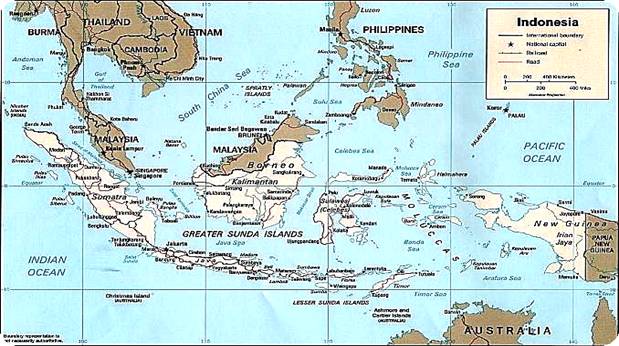
complete map of Indonesia
Indonesia’s capital Jakarta is situated in Java
|
1. Past Historical Links:
As we all know, India and Indonesia have been having trade and cultural links for the last 2000 years. The start was made by Indian Traders, who were the first to arrive there in the 1st Century. Hinduism and Buddhism were next to follow. Even today a ship starts from the port of Paradeep in Orissa to Bali. The voyage is known as Bali Yatra.
The earliest historical record is in Ujung Kulon National Park, West Java. An early Hindu archeological relic of a Ganesha statue from the 1st Century AD has been found on the summit of Mount Raksa in Panaitan Island. The next historical record is in the area of Kutai on the Mahakam River in east Kalimantan. Three rough plinths dating from the beginning of the fourth century are recorded in the Pallavi script of India. The inscription reads: “A gift to the Brahmin priests”.
This inscription is followed by the famous Batu Tulis (stone writing) near Bogor in Western Java. On a huge black boulder in, around 450 A.D king Purnawarna inscribed his name and made an imprint of his footprints, as well as his elephant’s footprints. The accompanying inscription reads, ‘Here are the footprints of King Purnawarna, the heroic conqueror of the world’. This inscription is in Sanskrit and is still clear after 1500 years. This is the oldest archeological monument in Java.
These two historical monuments are followed by (Candi) Badut near Malang in East Java built in A.D 760. Candi is the name of the Hindu Goddess of Time and Death. This area is literally strewn with ancient Hindu temples and even today temples are being dug out from the ground.
During the 8th and 9th century, the world’s largest Buddhist complex Borobudur and Prambanan the largest Hindu temple complex in Indonesia were built near Yogyakarta in Central Java. In the 10th Century, students were sent to Nalanda Buddhist University in N.E. India.
|
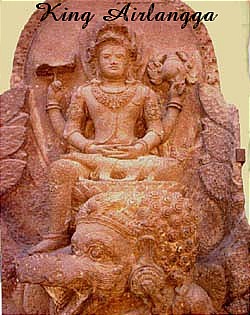
|
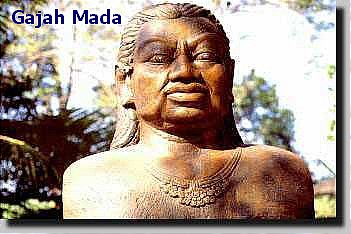
King Airlangga in the 11th Century was a great scholar. He got many sastras of India translated into ancient Kawi language. |
In Sumatra in the 12/13th Century arose the great Kingdom of Sriwijaya. However, it was during the reign of King Hayam Wuruk of the Majapahit Kingdom that the Prime Minister Gajah Mada united the entire Indonesia into a single state. It was the golden era of Indonesia.
The other important links where Sanskrit inscriptions have been found are at Batu Tulis, near Bogor, Joko Dolog in Surabaya and at iron pillar at Sanur in Bali. In the sixteenth century Islam was gradually introduced by the Indian merchants from Gujarat and today Indonesia is 90% Muslim.
2. Present Links:
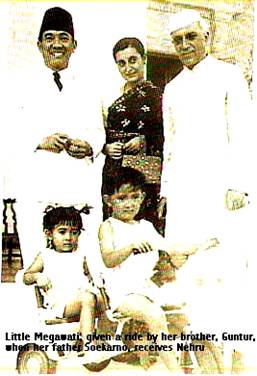 |
In August 1927 when Rabindranath Tagore, the Nobel prize winner arrived at Tanjung Priok harbor, he burst into a verse in the memory of the golden threads of kinship that have existed between India and Indonesia.
In 1932, Dewantoro, the founder of Taman Siswa Schools, painter Affandi and Dr. Ida Bagus Mantra visited Tagore in India at Shanti Niketan.
In 1947, Biju Patnaik came to visit Soekarno in Indonesia. Soekarno's wife had just given birth to a baby girl. It was raining heavily and Biju Patnaik suggested the name of "Meghawati" (Megha in Sanskrit means rain cloud). At present moment, Megawati, Soekarnoputri, the daughter of Soekarno is the President of the Republic of Indonesia. She is thought of as Putri of India also by the older generation.
In 1947, Biju Patnaik flew a private plane full of medicines to Indonesia and also rescued Mohammad Hatta and P.M. Sutan Sjahrir from the Dutch and brought them to India. In 1951 when Nehru visited Bali he said, "this is the morning of the world".
Nehru of India, Nasser of Egypt and Soekarno of |
Indonesia were the main architects of the policy of cooperation by the exploited nations against the rich nations. Ever since the political, business and cultural relationship between the 2 countries has been excellent. The first Asian African conference held in Bandung in 1955 brought Indonesia and India very close to each other.
3. State Policy:
The national emblem of the Republic of Indonesia – “Garuda Pancasila” is adorned with the
| with the words Bhineka Tunggal Ika- which means Unity in Diversity. The concept of Bhineka Tunggal Ika was started during the 8th–9th centuries in Central Java to create an understanding between Hinduism and Buddhism. Classic example is Candi Shiwa - Buddha. Afterwards King Airlangga made use of it in the 11th century. However it was Mpu Tantular the court poet of the Majapahit kingdom who during the reign of King Hayam Wuruk propagated this idea of a Unity in Diversity, in his poem |
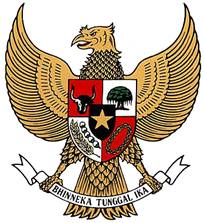 |
National emblem. Mention must be made here of Panca Sila, the 5 basic principles of the Republic of Indonesia. They are: Faith in one God, Nationalism, Democracy, Humanity and Just Society. All over Indonesia, at Govt. places you see Garuda, the vehicle of the Hindu God Vishnu alongside with a Panca Sila plaque. Indonesians are extremely proud of their historical cultural past. Indonesia like India is secular and even one of their currency notes carries a picture of Lord Ganesha. |
Garuda in the Indonesian history holds a place of honor. It is a symbol of national emblem with Wishnu riding it. Garuda sculpture is shown in countless temples. Garuda stands for complete devotion to Lord Vishnu and subsequent freedom from evil. Garuda also stands for the freedom of the people of Indonesia from foreign rule.
4. Language:
Although there are hundreds of dialects throughout Indonesia, yet Bahasa Indonesia in roman script is understood everywhere and this is what unites them all in their outlook. Indeed “Bhineka Tunggal Ika” ‘Unity in Diversity’ stands proved through Bahasa Indonesia, which shares many common words with Sanskrit like Guru, istri, suami, putri, putra, warna, Akasha and niscaya. Bahasa Indonesia is a very artistic language. Matahari means eye of the day which means Sun. Bunga Uang means flower of money, which means interest. The Japanese encouraged the use of Bahasa Indonesia for ulterior motives but the language grew into a great unifying factor under Soekarno.
5. Customs and culture:
Indonesia is a very cultured country where they have fixed hereditary cultural customs called Adat. It is appreciated when one does not talk or laugh loudly, keeps a smiling face, even when things go wrong and shows special respect to elders. Children are adored and pampered but controlled well. Never call anyone raising your finger, or give or receive anything with the left hand. Do not touch the head of a child even out of affection, for they believe the head is the seat of the soul. Dress properly when you visit a temple, a mosque, a church or a Vihara.
6. Volcanoes:
Indonesia has well over 300 volcanoes, out which more than 100 are active. Krakatau, which lies between Sumatra and Java, blew up in 1883 shooting debris 27Kms in the air. Subsequent ash and dust clouds could be seen as far as Central America, a few thousand kilometers away. It was the biggest volcanic eruption of the world. The crater made was 40 sq. kilometers wide and 300 meters deep.
7. Climate:
Climate throughout the year is moderate, so you could do well with cotton clothes. However it can be very cold at high altitudes, so plan accordingly.
8. Agriculture:
Indonesia is an agricultural country and has a great forest area and an exceedingly fertile land. Rice, coconut and bananas grow almost everywhere, besides cotton, palm oil, rubber, cocoa, tea and coffee. The variety of fruits is beyond description. Many of them are unknown in India and elsewhere. Pisang Raja a type of banana grows to almost 1 foot in length.
9. The Fabulous Spices of Indonesia especially cloves, nutmeg and cinnamon first attracted the Indian Traders in the 1st century. Afterwards the Portugese, Dutch and the British came to Indonesia and fought wars over the spices with the Indonesians as well as amongst themselves.
10. Oil and Gas:
Indonesia is an oil producing country and most of the reserves are located in Central Sumatra. The gas reserves are in the North Sumatra. Indonesia is the world’s largest exporter of liquefied natural gas.
11. Rain Forests:
Indonesia has large rain forests in Kalimantan and Irian Jaya.
12. Currency: The Rupiah is the official currency of Indonesia and at present one US dollar can be exchanged for around 9000 Rupiah. One of the currency notes carries a photo of Lord Ganesha.
13. Industry:
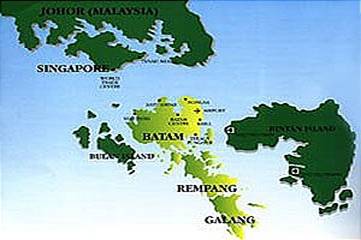 |
Very recently Indonesia has entered the industrial world in a big way. They have fitted up the most modern refineries and chemical plants. The entire Batam island, which is 12 kilometers from Singapore, has been converted in a free trade zone. Batam is connected to two other islands Rempang and Galang with most modern bridges. The development of this area has been fantastic. |
14. Mufakat and Musyawarah: Coming to an agreement after mutual discussion wherein the views of voters in minority are equally respected.
15. Gotong Royong: Means joint responsibility and mutual cooperation amongst the people under normal or emergency conditions.
16. Religion: Although the majority follows Islam, yet every one is free to practice one’s own religion. Thus Islam, Hinduism, Christianity and Buddhism coexist with each other. The Indonesians believe a lot in Mysticism and Spiritualism, and attach a lot of importance to it. Solo or Surakarta in Central Java is the mysticism Centre of Indonesia. Mention may be made of Sumarah foundation where they make use of yoga terminology of various Chakras. A large number of Indonesians follow Animism, which believes that there exists a hidden power (Spirit) in everything: in Trees, Rivers and Mountains, etc.
17. Literature: Ramayana and Mahabharata are most popular in Indonesia. They were probably translated in the 11th century during the reign of King Airlangga in the ancient Kawi language. King Airlangga was himself a great scholar and ascetic who spent many years in the jungle in meditation. Ramayana and Mahabharata are the basis of innumerable dances, plays, sculptures, paintings and music themes. The entire ancient literature has been written on the leaves of lontar palm. The literature has thus been preserved well in many libraries of Indonesia and also at Gedung Kritya in Singaraja in Bali.
1. Ramayana: Ravana the evil king of Sri Lanka kidnaps Sita, the wife of Lord Rama. In the battle that follows, Lord Rama kills the evil king with the help of Hanuman the monkey king and his followers and rescues his wife Sita. Thus Virtue prevails over evil. Ramayana exhorts us to lead a life based on Dharma.
2. Mahabharata: It relates about the war between two families, the Pandavas and the Kauravas. During the battle Lord Krishna gave a discourse to Arjuna that it was his dharma to oppose evil and injustice. Finally he convinced him to fight the evil Kauravas and defeat them.
3. Arjuna Wiwaha about heroism of Arjuna was written in 1035 AD by MPU Kanwa.
4. Bharat Yudha about the battle between Pandavas and Kauravas was written in 1157 AD by MPU Sedah.
5. Panji Cycle: Originated in East Java 500 years ago. It is written about Prince Panji and his beautiful bride Candra Kirono (Ray of the moon). Tales from Panji cycle are the basis of many masked and puppet dances.
6. Letters of Javanese Noble: In modern literature, special mention must be made of Raden Adjeng Kartini, who wrote this modern master piece. It describes the patriotic feelings of Kartini through letters written to Dutch friends. She also wrote strongly in favor of education for women and their welfare. Kartini’s day is celebrated throughout Indonesia with public meetings, lectures and parades etc. in order to propagate her ideas.
7. Chairil Anwar's angry poems against Japanese are well known.
8. Rendra was another gifted poet, actor and a great director of dramas. |
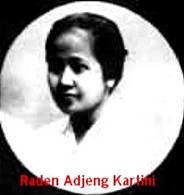 |
9. Panchatantra: In India Panchatantra holds a unique place. It was written in 200 B.C. by Pandit Vishnu Sharma. It has now been translated in modern Indonesian recently. It is about 3 princes who were absolute idiots. The king hands them over to a great scholar Pandit Vishnu Sharma, who arouses their interest by telling them stories about animals. Very cleverly, through these stories, he imparts knowledge to them and guides them how to live in harmony with all. After Ramayana and Mahabharta, Panchatantra is the most popular Shastra in India.
|
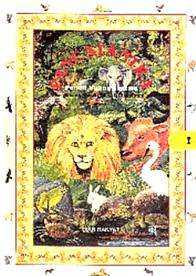
Indonesian version
Translated by Jyoti Daryanani and Chandiramani
|
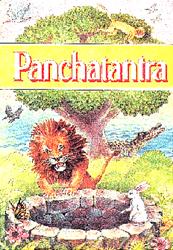
English version
Translated by Chandiramani
|
18. Badui Tribe:
For the last 400 years this Hindu tribe has been allowed to stay in isolation and maintain their customs and culture in an area of 50 kms on a mountainous area in Java called Kendeg.
19. Tenggerese:
Around 3, 00,000 Tenggerese live in 40 villages around Mount Bromo at a height of 3000 meters. They follow a religion that is a mixture of Hinduism and Buddhism. They live in complete harmony with all. They are highly respected for their straight forwardness. You will find a huge tree in every village strewn with flowers and people saying prayers under it. Also every year the Tenggerese observe Kasada ceremony when they offer sacrifices to God of Mount Bromo.
20. Music:
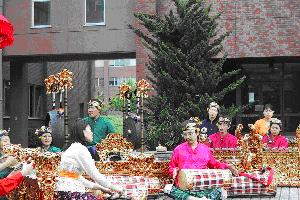 |
There is a lot of similarity between our music systems. Tilang, Bhopali and Shudh Sarang are few of the common ragaas between our two systems. Special mention must be made of their gamelan music which is soul stirring. It is a percussion type orchestra made up of mainly bronze and wooden xylophones. Drums, flutes, gongs, and sometimes singers and dancers join in to make it livelier. Sundanese music is the nearest to Indian music. The orchestra consists of Kecapi, a string instrument, Gendang drums, flute, iron gongs, and Angklung that is a frame made out of bamboos. |
21. Dances: Ballets based on Ramayana & Mahabharata are worth mentioning. There are innumerable types of dances but special mention must be made of Wayang Kulit, a shadow dance. It is usually a one-man show by a person called Dalang who controls the movements of various puppets plus talks with various voices befitting each character. Shadow dance has been practiced in Indonesia for the last 2000 years and probably the inspiration came from South India. Tales from Mahabharata, Ramayana and Panji cycle are frequently used in Wayang Kulit.
|

Indonesian masks
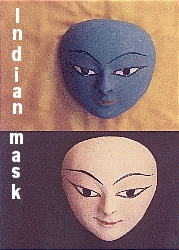
|
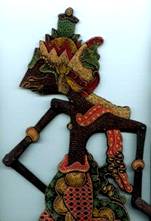
Wayang Kulit |
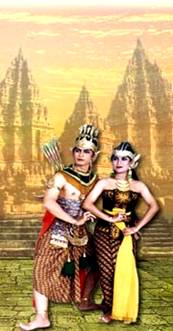
Rama and Shinta (Sita) from Ramayana |
There is a lot of similarity between our dances. The popular Chau (masked dance) dance of Orissa is Topeng (masked dance) of Indonesia. The similarity is astounding. However each area in Indonesia has its own local dance. Each one is unique. Do not miss it.
Like in Java, you have Reog, Bedaya Kitawang and Golek Ayun; in Bali, Kecak, Legong and sang Hyang Dedari (trance); in Sumatra, the Lilin (Candle) and Rontak dance. In Sulawesi, they have Pakarena dance praying for the safe return of the seaman. In Kalimantan they have Giring dance which is a ritual dance. In Irian Jaya, they have Maori dance which is a war dance.
|
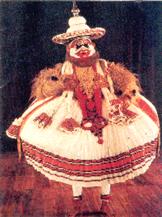 |
|
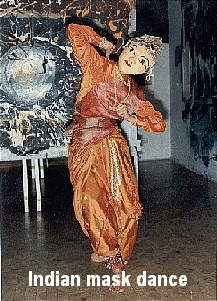
Chau dancing by Prakriti Kashyap |
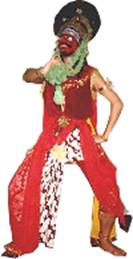
Indonesian mask dance |
22. Drama
Each part of Indonesia has its version of dramas.
In Java Ludruk is very popular. It is mainly taken from mythology, history and local life. Many times it is a satire.
Ketoprak is another extremely popular drama covering all aspects of life. Dancing and singing also accompany this drama.
23. Keris:
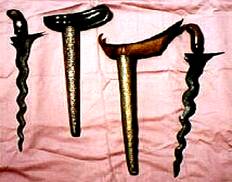 |
The Indonesians attach a lot of value to Keris, a wavy bladed dagger inherited as family heirloom. Once a year it is worshipped with burning of incense and prayers. A Keris is supposed to have a spirit and is treated with great respect. The keris is considered a magical weapon, filled with great spiritual power. In Javanese there is a term "Tosan Aji" or "Magic Metal" used to describe the keris. The keris is replete with the totems of Malay-Indonesian culture; Hindu and Islam. |
24. Batik:
One of the most developed textile lines- the batik printing involving wax printing is the most important in Indonesia. It is at least 4 centuries old. Yogyakarta is the centre of Batik printing. On all official government functions, it is mandatory to wear Batik. Batik Tulis (Writing) is
| another popular type of cloth printing. The designs in both types are beyond words. Solo (Central Java) is very well known for its Batik creation and motif. |
|
|
25. Silk industry:Garut, which is around 60 km from Bandung, is the centre of cultivation of silk worms. Silk threads are woven into fabrics which are subsequently mildly scoured or even bleached very lightly. Subsequently Batik printing takes place producing a very high quality of silk Batik.
26. Food:
Since they have thousands of islands, the variety of seafood is beyond words.
For the vegetarians: 1. Gado-Gado: which consists of all types of vegetables with peanut sauce is nowadays recognised as an international dish.
2. Martabak: It is a pancake which can be stuffed with vegetables.
3. Nasi Goreng: Fried rice is also available with vegetables only.
4. Mie Goreng: Fried noodles with vegetables only.
5. Tempe: It is made from fermented soya bean.
6. Ketan: Rice pudding
7. Bubur Santen: Rice porridge.
8. Coconut cakes
9. Crunchy peanut cookies
For the Non-Vegetarians:
1. Sate Ayam: Barbequed pieces of chicken roasted over charcoal fire.
2. Opor Ayam: It is chicken cooked in coconut milk with spices.
3. Nasi Goreng: Fried rice is also available with chicken.
4. Ikan Asin Manis: It is a dish of fish with sweet and sour taste.
5. Krupuk: Made out of shrimps in the form of papads.
27. Fruits:
| There are so many fruits in Indonesia, which are not grown in India or elsewhere. Try Durian, which stinks like hell but tastes like heaven, mangosteen rambutan, salak, duku, avocado, belimbing, jambu, guava, sirsak, langsat, buih, jambu air, sawo and markisa are other fruits, not to forget pineapples and bananas. Pisang Raja is a type of bananas which is almost one foot in length. |
 |
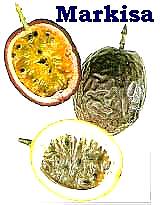 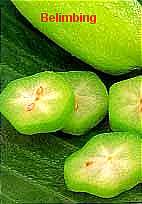 |
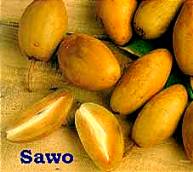 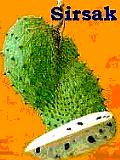 |
28. Drinks: Beer, Brem (Rice Wine), Arak, Buah es (Mixture of Fruits) with honey and condensed milk.
Infrastructure:
With ultramodern airports, super highways, 5 Star Hotels and modern communication facilities, Indonesia has entered the modern world with a bang. Indonesia offers great possibilities for trade with India, with its abundance of raw materials like oil, gas, timber and other agricultural products.
29. Tourism:
With its numerous mountains, volcanoes, islands and ancient monuments dating back to 400 A.D, Indonesia offers a lot to the tourists. Ask for special brochure Candi Yatra, honeymoon in Bali and Batam island near Singapore.
(This brochure clearly states as to what may be visited).
Java:
Western Java
Jakarta was once a Hindu kingdom called Pajajaran. Afterwards in the 16th century, it was conquered by Muslims and renamed Jayakarta (Great Victory). Afterwards the Dutch conquered it and renamed it as Batavia. After Indonesia declared independence, it was named Jakarta, a short form of Jayakarta.
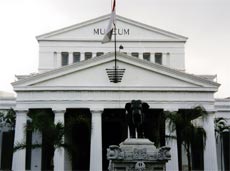 |
1. Ujung Kulon National Park: An early Hindu relic of Ganesha from the First Centeury AD has been found here.
2. Batu Tulis: refer to page one.
3. National Museum: It has sculptures of Brahma, Vishnu, Shiva, Buddha, Ganesha and many other Hindu Gods and is rated as one of the best museums in the world. The Museum Nasional or National Museum built in 17th Century has a wealth of stone statues in many different forms and sizes, most notably relating to ancestral worship. The most notable statues are of Brahma, Vishnu, Shiva, Ganesha and Buddha.
|
|
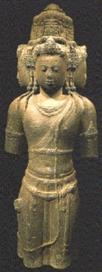
Brahma
Stone statue,
Banon temple,
Magelang,
Central Java
10th - 11th C
Height= 150cm
|
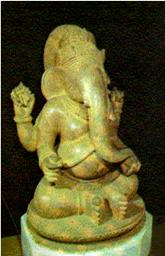
Ganesh
Stone statue, Banon temple, Magelang, Central Java, 8th C, Height= 148cm
|
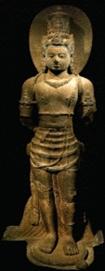
Vishnu
Stone statue,
Banon temple,
Magelang, Central Java
10th - 11th C
Height= 296cm
|

Buddha
Stone statue, Borobudur temple, Central Java, 9th C, Height= 106cm
|
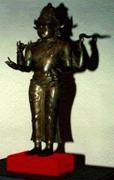
Shiva
Bronze statue, Adiwerna, Tegal, Central Java
10th - 11th C
Height= 96cm
|
Photos by courtesy of Ms. Endang Sri Hardiati, Director of the Museum Nasional
4. National Monument: MONAS.
It symbolises fertility. It is over 135 metres tall and is coated with 35 kilos of pure gold. From the top, one can have a view of Jakarta. The basement houses a museum of nation’s history.
5. Jaya Ancol: Ancol Dream Land. It is the biggest recreation area in S.E. Asia. One of its main features is Dunia Fantasi (World of Fantasy). It is open 24 Hrs.
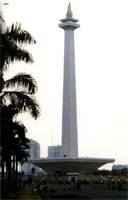 |
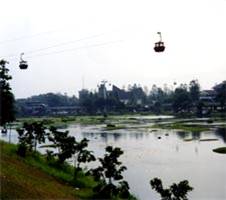 |
Jaya Ancol is Jakarta's all-in-one recreation park and a great place located on the waterfront to the north of the city. In this place you can find:
ANCOL ART MARKET
This is an outdoor art market and recreational place where you will be most tempted to purchase something. Items include antiques, handicrafts, paintings, pottery, and knickknacks. With many of the artisans working on site, it is a paradise for souvenir hunters and art lovers.
|
SEA WORLD
Inside the Ancol Dreamland complex. Sea World is a high-tech huge modern aquarium exhibiting the special and diverse tropical marine life found throughout the Indonesian waters. Stroll through the Freshwater World to see beautiful tropical fish and coral reefs, get friendly with marine life at the Touch Pool, and walk through the acrylic tunnel that gives first-hand experience of life under the sea
 |
DUNIA FANTASI (Fantasy World)
It is a fun theme park designed to entertain visitors with the fascinating worlds of modern science and technology. The facilities take visitors on imaginative tours of Africa, America and Indonesia through some breathtaking games.
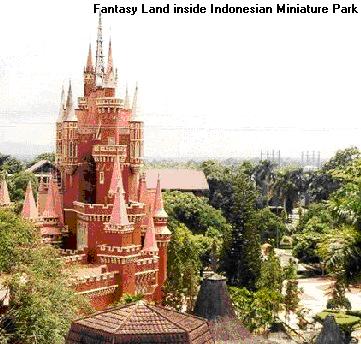 |
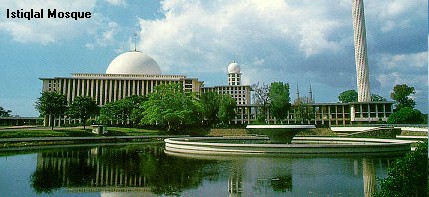 |
6. Istiqlal Mosque: It is the largest mosque in Asia and is worth visiting. It was built by Soekarno.
7. Taman Mini :
Beautiful Indonesia in miniature park presents all the diversities of the rich culture of Indonesia giving an insight into their skills, architecture, customs, etc |
Taman Mini
8. Mahabharata: scene sculpture showing Lord Krishna driving Arjuna in a chariot
|

Arjuna Wijaya statue, Jakarta |
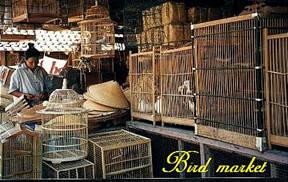 |
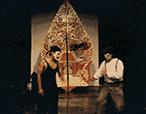
10. Taman Ismail Marzuki (TIM):
TIM is the centre of dance, music, drama and culture in Jakarta. Dramas, dances, music, lectures and shadow plays are constantly going on.
|
|
11. Shopping:
Sarinah Departmental Store is one of the leading departmental stores, where the prices are fixed and you can do some sensible shopping. Everything is available here.
Block M is another modern departmental store.
Don’t forget Jalan Surabaya - flea market.
|
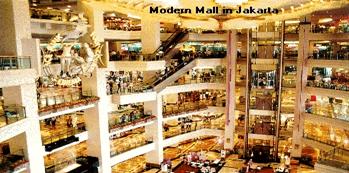 |
CENTRAL JAVA
Yogyakarta: (Jogja)
Kalasan, Sari and Sewu are the satellite temples nearby Prambanan Hindu Temple Complex.
|
4. Taman Sari: Water Castle: In the past it was a bathing place for royalty. Nowadays it has become a place for meeting of artists as well as a centre for art, culture, and paintings. The name 'Taman Sari' evokes the fragrance and grace of a lush Javanese garden, with bees probing for nectar in masses of flowers.
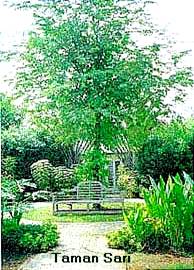
|
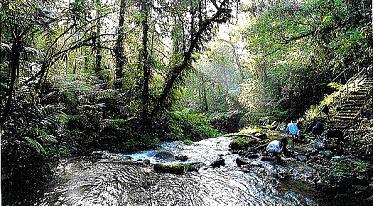 |
|
5. Kraton: Sultan’s palace: It is like a walled city, which is run by the Sultan’s palace with Gamelan music and dances going on and on. It is a place of culture and tradition.
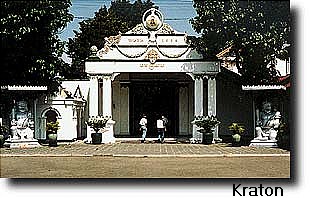
|
|
6. Nyai Roro Kidul: The goddess of the South seas is offered special tribute by the Sultan of Yogyakarta every year in a very colourful ceremony, in which thousands of people participate.
7. Gajah Mada University: Jogjakarta has the largest university in Indonesia.
8. Sedangsono: This Catholic centre of pilgrimage is 32 kms. from Yogyakarta. A statue of Virgin Mary is installed in a mountainous area. In the village nearby, the water is supposed to be holy. Picture on the next page shows a statue of Maria in Hindu attire inside the church at Ganjuran, Sedangsono.
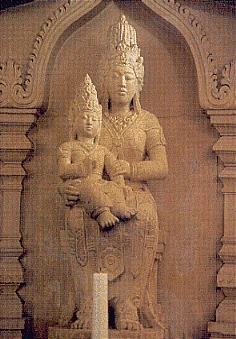 |
9. The Dieng temples: The Dieng temples were built in the 8th Century and are named after the Pandawas like Candi Arjuna, Candi Bima, etc.
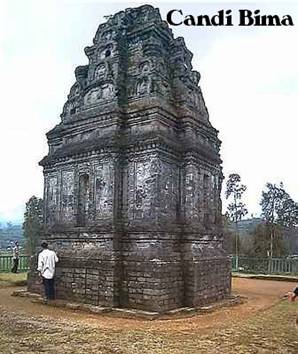
|
10. Solo Candi Sukuh: It is like Khajuraho temple in India depicting sexual themes. It is near Solo.
Demak: In 1478 A.D, near Semarang, the oldest mosque in Java was built. It is considered very holy and is a place of pilgrimage. It is in Central Java and is 25 kms away from Semarang.
|
Madura: It is famous for KARAPAN SAPI, a very colorful bull race which is held every year after harvest time.
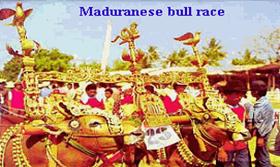
|
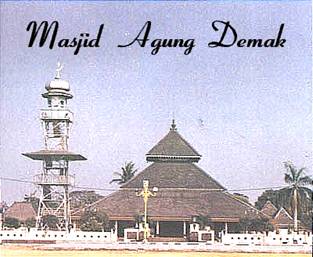 |
East Java
East Java is known for its exotic beauty and ancient Hindu temples.
1. Candi Badut: is the oldest temple in Java near Malang and was built in 760 A.D.
2. The other temples in the area are candi Gunung Gangsir (10th Century) - Candi Kidal (13th Century) - Candi Jago (14th Century), Candi Jawi (14th Century) and finally Candi Singosari.
3. The cave Hermitages: East Java is known for its cave Hermitages, where Kings and Queens used to retire in the old age to meditate and get enlightenment. The best-known caves are near Tulungagung. King Airlangga, the Majapahit Queen mother and King Rajasanagar went there to meditate.
4. Penataran temple complex near Blitar: It is also called the dated temple, for various dates have been insribed in those temples. The construction of this complex started in 1197 and ended in 1454; nearly 250 years afterwards. King Hayam Wuruk of the Majapahit Kingdom used to visit it regularly.
5. Trowulan Museum: This museum has the maximum treasures of East Java. Mention may be made of the portrait statue of King Airlangga as Vishnu on Garuda. And a relief in a temple shows Samodra manthan, the churning of the ocean of milk by the Gods.
6. Blitar: is another very important temple complex. Soekarno, the first President of the Republic of Indonesia lies buried in Blitar.
7. Bara Ganesha: near the village of Bara stands majestically in a garden a gigantic statue of Ganesha built in the 14th Century.
BALI:
This unique island is Indonesia’s most popular tourist spot. It has thousands of Hindu temples. It has a population of 90% Hindus, plus Muslims, Buddhists and Christians. There is so much to see in Bali, that one would go crazy. Everyday there is some temple ceremony. It is indeed correctly called “Paradise Island”. Practically every person is either an artist, painter, or doing sculpture in stone, wood or silver. He has to be something to gain respect in the community. Denpasar is the capital.
1. Besakih: This is known as the mother temple of Bali and must be visited. The scenic beauty along the route is beautiful. In 1963, there was a volcanic eruption. The molten lava would have destroyed the temple. It however stopped at the foot of the temple.
5. Trowulan Museum: This museum has the maximum treasures of East Java. Mention may be made of the portrait statue of King Airlangga as Vishnu on Garuda. And a relief in a temple shows Samodra manthan, the churning of the ocean of milk by the Gods.
6. Blitar: is another very important temple complex. Soekarno, the first President of the Republic of Indonesia lies buried in Blitar.
7. Bara Ganesha: near the village of Bara stands majestically in a garden a gigantic statue of Ganesha built in the 14th Century.
BALI:
This unique island is Indonesia’s most popular tourist spot. It has thousands of Hindu temples. It has a population of 90% Hindus, plus Muslims, Buddhists and Christians. There is so much to see in Bali, that one would go crazy. Everyday there is some temple ceremony. It is indeed correctly called “Paradise Island”. Practically every person is either an artist, painter, or doing sculpture in stone, wood or silver. He has to be something to gain respect in the community. Denpasar is the capital.
1. Besakih: This is known as the mother temple of Bali and must be visited. The scenic beauty along the route is beautiful. In 1963, there was a volcanic eruption. The molten lava would have destroyed the temple. It however stopped at the foot of the temple.
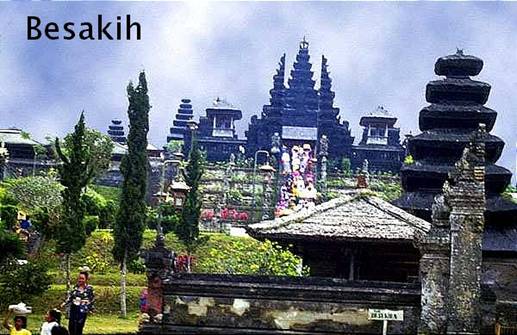
2. Bedugul: (Ulan Danu) The view on this route is breath taking. The temple Ulan Danu is in the lake itself.
3. Tanah Lot:
This temple is on a cliff and must be visited.
It was built in the 16th century by the famous priest Naratha. On the way, if possible do see the monkey forest.
|
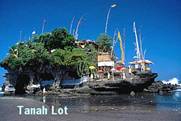 |

4. Goa Gajah: This 11th century temple has a statue of Ganesha. It was built as a monastery. |
5. Tampaksiring: 1000 years old temple built around a sacred spring.
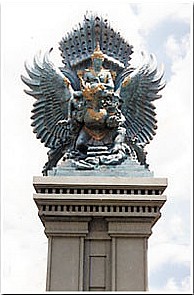 |
6. Garuda Wishnu Kencana: is a modern complex built near Ulu. Watu temple at the southern tip of Bali.
7. Sanur Iron pillar: Inscription in Sanskrit on it is nearly 1000 years old. It describes the victory of a king over his enemies
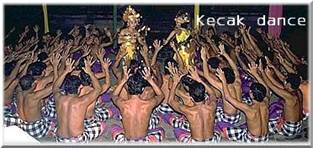
8. Kecak: Monkey dance; Sita wife of King Rama is surrounded by dancers who keep uttering Chak-Chak in unison. The whole atmosphere is charged with emotion. Kecak dance is from Ramayana. |
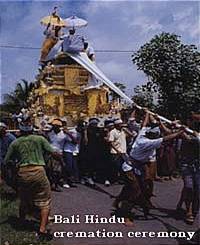 |
9. Hindu Cremation ceremony. If you are lucky, you will see this fantastic ceremony. In Bali, death is considered as liberation from worldly attachments and is an occasion for celebration |
10. Barong and Rangda Masked Dance:
This dance depicts the victory of virtuous Barong over the evil Rangda
 |
11. Serangan: Turtle island: Watch the turtles lay eggs. Giant kites are flown here, especially on a festival day.
|
12. Kuta Beach: Sunset on this international beach is claimed to be exotic and world famous
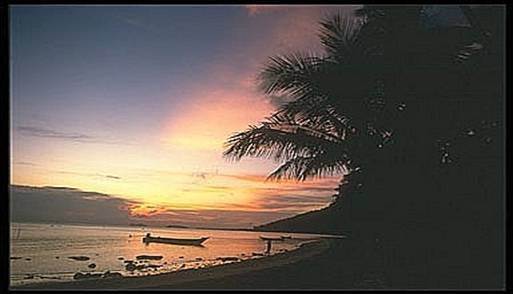
|
14. Common scene in Bali:
13. Moon of Pejeng: A huge gong, the largest of its kind
|
Ladies offering fruits to the Gods.
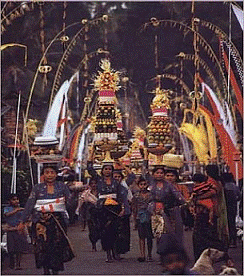
|
in the East, is one of the archeological masterpieces in Bali. The Balinese consider it to be charged with magical power.
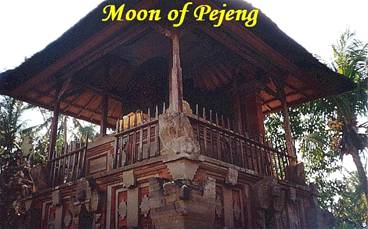
|
Sumatra:
1. Lake Toba: It is the largest lake (8000sq.km) in Southeast Asia and one of the deepest and highest in the world. It has an island in its midst, named Samosir.
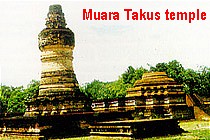 |
2. Muaro Takus Temple ruins: Nearly 10sq.kilometres of ancient Hindu temples built in the 11th/12th century lie scattered over here.
3. Maligai Stupa: This magnificent structure is classic and geometrically built.
4. Minangkabau: Here you have the largest matriarchal society of the world, wherein women control everything and property is inherited by the daughters. Minangkabau means The Victory of the buffalo, Bukittinggi is the centre of culture and etc.
|
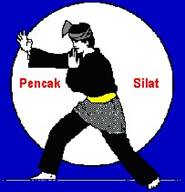 |
5. Pencak Silat:
This is the unique form of self-defence as well as dance form.
|
 |
Molucas: It is another important area of Indonesia which covers approximately one thousand islands of which Ambon is most known. It has a very rich tradition of dance and music. They have a special Gamelan Orchestra called Totebang. They have also a bamboo dance which is called gaba-gaba. Molucas is known for its gigantic production of cloves.
Sulawesi: Tanah Toraja, corpses are sealed in rock cemeteries hewn out of mountains. It is at 10 hours drive from Ujung Pandang. It is a very popular tourist spot. It is only here that the puppets.
Cliffside grave, Tanah Toraja
Looking like humans are worshipped. Here life sized effigies of the dead are placed in high balconies carved in Limestone cliffs to protect the treasures of the dead.
Kalimantan: Many large rivers flow from the central mountains of Borneo into the sea. The jungle and the interior of Borneo is one of the most mysterious and exotic places on Earth. Oil and Timber are the major exports.
Irian Jaya: Capital is Jayapura. It is 80% forest area. Lakes, flowers, wild streams are abundant. It has the highest mountain in Indonesia called Jayawijaya, which is always covered by snow.
What Nature has given only to Indonesia
 |
1. Reticulated Python: One of the world’s largest and the longest snake, 9 meters in length
2. Orangutan: (Man in the forest). A huge ape type animal living on trees with a thick reddish fur. It is a native of Sumatra. It is an endangered species. The rescued orangutans are reintroduced to natural wild at Tanjung Puting Park. It is a place worth visiting.
|
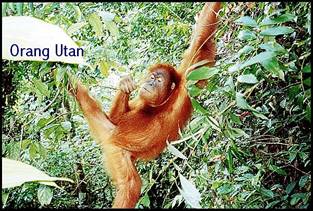 |
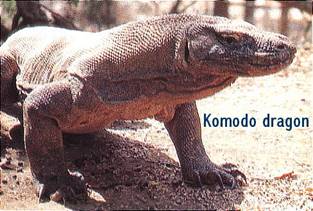 |
3. Komodo dragon: Is the largest lizard in the world weighing over 150kgs. It can grow upto 3 metres in length. It can climb trees and prey on monkeys. His tail can kill a buffalo with one stroke.
4. Rafflesia: A giant insect eating flower, one meter in diameter and weighing 7kilos, which blooms in October. Named after Raffles, the only English Governor General of Indonesia.
5. Crimson Bird of Paradise: Only on the island of Waigeo the crimson bird of paradise is found.
6. Pattae Cave: A cave painting of a leaping bear with a spear through his heart in 10000 a B.C. to 2000 B.C. in South Celebes (Sulawesi).
7. Glory of the Seas: World’s extra ordinary shell which is extremely rare and costly beyond words is found in Indonesia.
8. The three-coloured Lake: In Flores, there is a lake in a volcanic crater showing 3 colours. No one knows how.
9. The Tree in Borneo: that does not float but sinks in water. Extremely hard and resistant to insects.
|
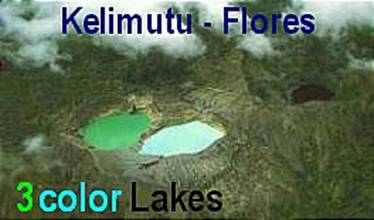 |
Pantun:
Lastly a word about Pantuns. Pantun in Indonesia is a verse having double meaning. Just like in Sanskrit. Here we are giving a classic example
The gardener looked after the flower,
One day a bee flew by
And the flower smiled at it.
When the grasshopper saw this,
He smiled too.
Here in the above verses the gardener stands for the father, the flower for the daughter, and the bee for the Prince charming and grasshopper for the spectator. Just study the subtleness of the verses. Sanskrit is full of such verses.
Dukuns:
They are the local medicine men who make use of the local Herbs (Jamu just like Ayurvedic herbs). They also recite Mantras to cure their customers of illness and cast black magic on the opponents of the customers.
Books on Indonesia:
History:
1. Background to Indonesia: Kilgour Ron.
Aukland -NewZealand
2. A History of Java Vol I-II. By Raffles: Thomas S.
Black Perbury & Allen London.
NewZealand.
Art:
1. Ancient Indonesian Art: Kompers Benet.
DPJ Van der Peet. Amsterdam:Holland.
2. Music in Java: Kurst Jaap: Nijhoff- Hague:Holland.
Literature:
1. Letters of a Javanese princess:Kartini Raden.
AA Knopf of New York
2. Twilight in Jakarta: Libris Mochter
Hutchinson-London
3. Panchatantra: An Ancient classic written in Sanskrit in 200B.C.by Pandit Vishnu Sharma. Basis of Tantri Tales and Kisah Tantri
Translated into more than 50 languages of the world. Now translated into Indonesian by Jyoti Daryanani and Chandiramani. Touched up by Sri Artaria.
Published by Dian Rakyat-Jakarta
Politics:
1. Soekarno_ Cindy Adams
Bobbs Merril_New York.
Travel:
1. Lonely Planet: Indonesia: Bobbs Merril: New York .
2. A Tale from Bali: Vicki Baum-Oxford-London.
3. Indonesia Handbook: By Bill Dalton.
Published by: Moon Publications-Rutland , Vermont 05701, USA.
Language:
How to master Bahasa Indonesia by Almatsier A.M.
Publisher Penerbit Djambatan.
Websites:
www.tourismindonesia.com
www.baliparadise.com
www.eastjava.com
www.batam.com
www.chandiramani.com
End of Matter